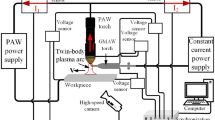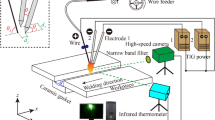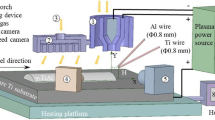Abstract
The wire tips in twin-wire arc-spraying (TWAS) are heated in three different zones. A high-speed camera was used to observe the melting behavior, metal breakup, and particle formation under different operating conditions. In zone (I), the wire tips are melted (liquidus metal) and directly atomized in the form of smaller droplets. Their size is a function of the specific properties of the molten metal and the exerting aerodynamic forces. Zone (II) is directly beneath zone (I) and the origin of the extruded metal sheets at the wire tips. The extruded metal sheets in the case of cored wires are shorter than those observed while using solid wires. In this study, the effects of adjustable parameters and powder filling on melting behavior, particle formation, and process instability were revealed, and a comparison between solid and cored wires was made. The findings can improve the accuracy of the TWAS process modeling.













Similar content being viewed by others
References
D. Sacriste, N. Goubot, J. Dhers, M. Ducos, and A. Vardelle, An Evaluation of the Electric Arc Spray and (HPPS) Processes for the Manufacturing of High Power Plasma Spraying MCrAlY Coatings, J. Therm. Spray Technol., 2001, 352, p 35-358
H.L. Liao, Y.L. Zhu, R. Bolot, C. Coddet, and S.N. Ma, Size Distribution of Particles from Individual Wires and the Effects of Nozzle Geometry in Twin Wire Arc Spraying, Surf. Coat. Technol., 2005, 200, p 2123-2130
A. Newbery, P. Grant, and T. Neiser, The Velocity and Temperature of Steel Droplets during Electric Arc Spraying, Surf. Coat. Technol., 2005, 195, p 91-101
A. Pourmousa, J. Mostaghimi, A. Abdini, and S. Chandra, Particle Size Distribution in a Wire-Arc Spraying System, J. Therm. Spray Technol, 2005, 14(4), p 502-510
M.P. Planche, H. Liao, and C. Coddet, Relationships Between In-Flight Particle Characteristics and Coating Microstructure with a Twin Wire Arc Spray Process and Different Working Conditions, Surf. Coat. Technol., 2004, 182, p 215-226
T. Watanabe, T. Sato, and A. Nezu, Electrode Phenomena Investigation of Wire Arc Spraying for Preparation of Ti-Al Inter-Metallic Compounds, Thin Solid Films, 2002, 407, p 98-103
A.P. Newbery, T. Rayment, and P.S. Grant, A Particle Image Velocimetry Investigation of In-Flight and Deposition Behavior of Steel Droplets during Electric Arc Spray Forming, Mater. Sci. Eng., 2004, A383, p 137-145
J. Stanisic, D. Kosikowski, and P.S. Mohanty, High-Speed Visualization and Plume Characterization of the Hybrid Spray Process, J. Therm. Spray Technol., 2006, 750(15), p 750-758
A. Mansour and N. Chigier, Disintegration of Liquid Sheets, Phys. Fluids, 1990, A2, p 706-719
S.P. Mates and G.S. Settles, A Study of Liquid Metal Atomization Using Close-Coupled Nozzles, Part 1: Gas Dynamic Behavior, At. Sprays, 2005, 15(1), p 19-40
S.P. Mates and G.S. Settles, A Study of Liquid Metal Atomization Using Close-Coupled Nozzles, Part 2: Atomization Behavior, At. Sprays, 2005, 15(1), p 41-60
N.A. Hussary and J.V.R. Heberlein, Effect of System Parameters on Metal Breakup and Particle Formation in the Wire Arc Spray Process, J. Therm. Spray Technol., 2007, 140(16), p 140-152
H. Steffens, “Haftung und Schichtaufbau beim Lichtbogen- und Flammspritzen, (Adhesion and Layer Structure for Arc and Flame Spraying),” Ph.D. thesis, Hannover Technical University, 1966 (in German)
N.A. Hussary and J.V.R. Heberlein, Atomization and Particle-Jet Interactions in the Wire-Arc Spraying Process, J. Therm. Spray Technol., 2001, 10, p 604-610
X. Wang, J. Heberlein, E. Pfender, and W. Gerberich, Effect of Nozzle Configuration, Gas Pressure, and Gas Type on Coating Properties in Wire Arc Spray, J. Therm. Spray Technol., 1999, 8(4), p 565-575
N. Hussary and J. Heberlein, Metal Droplet Formation Mechanisms in the Wire Arc Spraying Process, 48, Internationales wissenschaftliches Kolloquium, Illmenau, 2003, p 22-25
J. Wilden, J. Bergmann, S. Jahn, S. Knapp, F. van Rodijnen, and G. Fischer, Investigation about the Chrome Steel Wire Arc Spray Process and the Resulting Coating Properties, J. Therm. Spray Technol., 2007, 16(5-6), p 759-767
W. Tillmann, E. Vogli, and M. Abdulgader, Asymmetric Melting Behavior in Twin Wire Arc Spraying with Cored Wires, J. Therm. Spray Technol., 2008, 17(5-6), p 974-982
Acknowledgments
The authors gratefully acknowledge the financial support of the DFG (Deutsche Forschungsgemeinschaft) within the collaborative research Centre SFB708/TP-B3.
Author information
Authors and Affiliations
Corresponding author
Additional information
This article is an invited paper selected from presentations at the 2012 International Thermal Spray Conference and has been expanded from the original presentation. It is simultaneously published in Thermal Spray 2012: Proceedings of the International Thermal Spray Conference, Air, Land, Water, and the Human Body: Thermal Spray Science and Applications, Houston, Texas, USA, May 21-24, 2012, Basil R. Marple, Arvind Agarwal, Laura Filofteia-Toma, Margaret M. Hyland, Yuk-Chiu Lau, Chang-Jiu Li, Rogerio S. Lima, and André McDonald, Ed., ASM International, Materials Park, OH, 2012.
Rights and permissions
About this article
Cite this article
Tillmann, W., Abdulgader, M. Wire Composition: Its Effect on Metal Disintegration and Particle Formation in Twin-Wire Arc-Spraying Process. J Therm Spray Tech 22, 352–362 (2013). https://doi.org/10.1007/s11666-012-9870-y
Received:
Revised:
Published:
Issue Date:
DOI: https://doi.org/10.1007/s11666-012-9870-y




